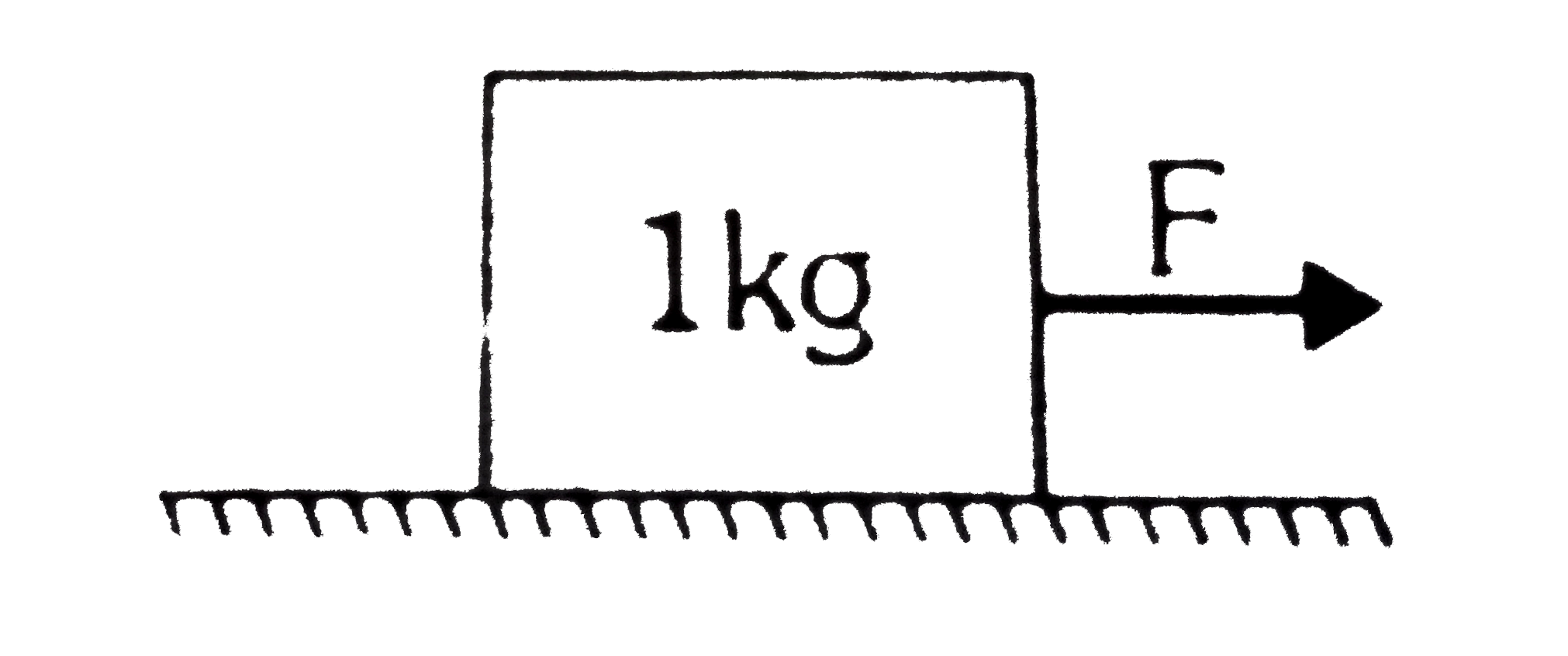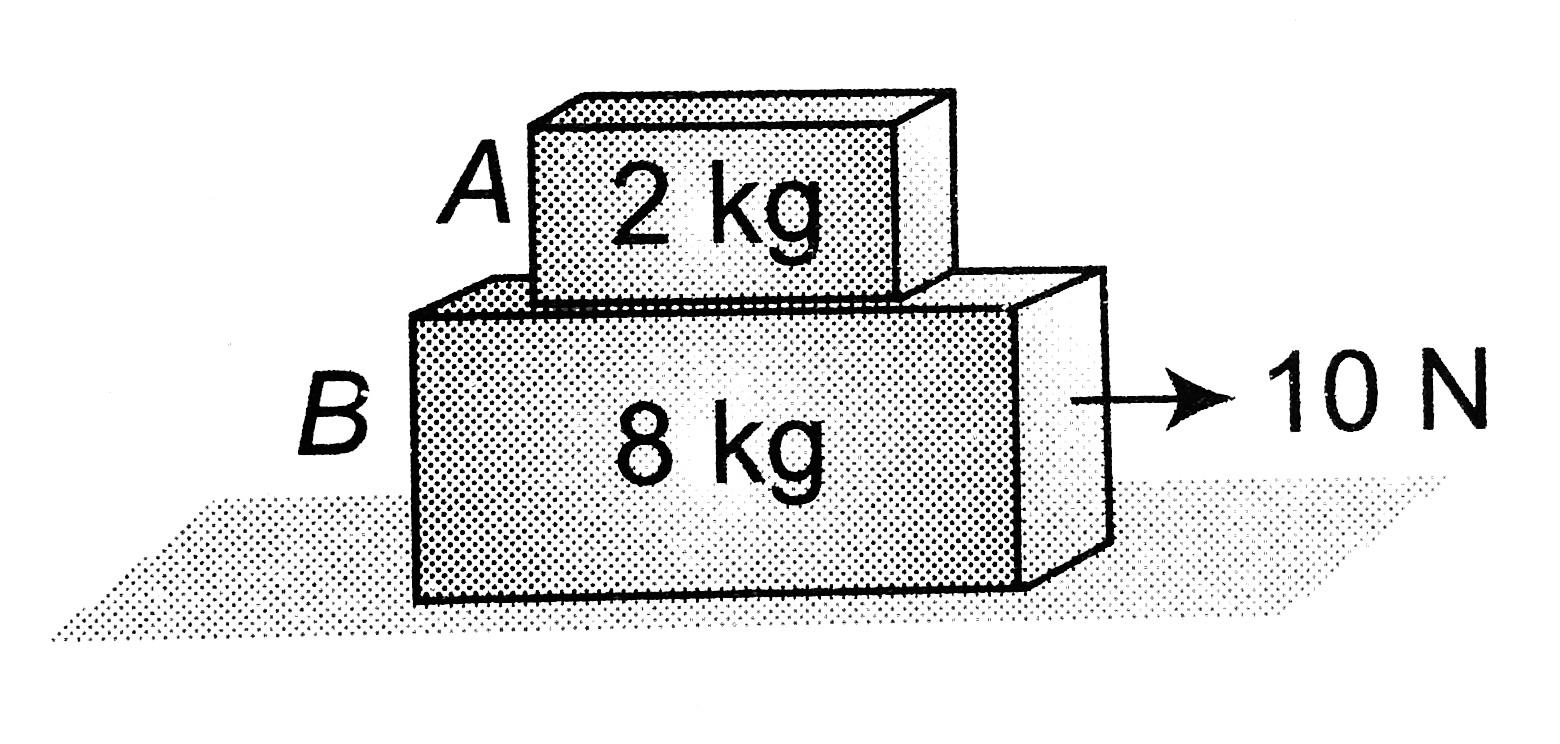A body of mass 10kg is placed on foxed rough horizontal surface. Coefficient of static friction is 0.6 and coefficient of kinetic friction is 0.6 and coefficient of kinetic friction is 0.4. If horizontal force 20Nis applied on the body find out the frictional force (g=10ms−2)
Limiting friction
fS=μSN=0.6×10×10=60N
Kinetic friction =0.4×10×10=40N
The force applied on the body is F=20N. Since the body remains at rest, frictional force is static in nature and its value is fs=20N.If we extend the discussion and make F=40N. fs will be 40 N and the body remains at rest. If F=59N then fs will be 59N and the body remains at rest. Static frictional force can take any volue between zero and 60N. Please note that in the formula fs=μsN,fs is maximum static frictional force or limiting friction. Its important to understand that the term static friction and limiting friction are not exactly the same. One should note that limiting friction is static in nature, but every static friction is not limiting friction. If F>60N the body slides on the surface, Hence the friction force involved will be kinetic frictional force and its magnitude will be fk=μkN.fk=0.4×10×10=40N
In Fig. 1.4 (a) (b), the block is subjected to three forces mg, PandR.(R. is the resultant of normal reaction N and frictional force f) and hence they must be concurrent.
R.=√f2+N2,tanϕs=fmaxN=μsNN,tanϕs=μs.........(1.2)
where ϕs is known as the angle of friction which represents the angle between the resultant R. and the normal reaction N. It is to be remembered that as long as θ<ϕs, the block is in equilibrium and when θ<ϕs, the motion is about to begin.

Similar Questions
A block of mass 1kg is at rest on a rough horizontal surface having coefficient of static friction 0.2 and kinetic friciton 0.15, find the frictional forces if a horizontal force,
(a) F=1N (b) F=1.96N (c) F=2.5N is applied on a block

View SolutionA block of mass 1kg is at rest on a rough horizontal surface having coefficient of static friction 0.2 and kinetic friciton 0.15, find the frictional forces if a horizontal force,
(a) F=1N (b) F=1.96N (c) F=2.5N is applied on a block

View Solution
Knowledge Check
A body of mass 2 kg is placed on a horizontal surface having coefficient of kinetic friction 0.4 and limiting coefficient of static friction 0.5. If a horizontal force 2.5 N is applied on the body, the frictional force acting on the body will be (Take, g=10ms2)
A8 NB10 NC20 ND2.5 NA body of mass 2 kg is placed on rough horizontal plane. The coefficient of friction between body and plane is 0.2 Then,
 Abody will move in forward direction if F = 5 NBbody will be move in backward direction with acceleration 0.5m/s2 if force F = 3NCif F = 3N, then body will be in rest conditionDBoth a and c are correct
Abody will move in forward direction if F = 5 NBbody will be move in backward direction with acceleration 0.5m/s2 if force F = 3NCif F = 3N, then body will be in rest conditionDBoth a and c are correctBlock A of mass 2kg is placed over a block B of mass 8kg . The combination is placed on a rough horizontal surface. If g=10ms−2 , coefficient of friction between B and floor =0.5, coefficient of friction between A and B=0.4 and a horizontal force of 10N is applied on 8kg block, then the force of friction between A and B is.
 A100NB50NC40NDNone of these
A100NB50NC40NDNone of these
A body of mass 25 kg, is placed on a horizontal surface whose coefficient of friction 0.25. Find the frictional force action on it. Take (g=10ms−2)
View SolutionA block of mass 5kg is lying on a rough horizontal surface. The coefficient of static and kinetic friction are 0.3 and 0.1 and g=10ms−2 The frictional force on the block is
View SolutionA block of mass 20kg is placed on a rough horizontal plane and a horizontal force of 12N is applied. If coefficient of friction is 0.1 the frictional force acting on it is,
View SolutionBlock A of mass 2kg is placed over a block B of mass 8kg . The combination is placed on a rough horizontal surface. If g=10ms−2 , coefficient of friction between B and floor =0.5 , coefficient of friction between B and floor =0.5 , coefficient of friction between A and B=0.4 and a horizontal force of 10N is applied on 8kg block, then the force of friction between A and B is.

View SolutionBlock A of mass 2kg is placed over a block B of mass 8kg . The combination is placed on a rough horizontal surface. If g=10ms−2 , coefficient of friction between B and floor =0.5 , coefficient of friction between B and floor =0.5 , coefficient of friction between A and B=0.4 and a horizontal force of 10N is applied on 8kg block, then the force of friction between A and B is.

View Solution

